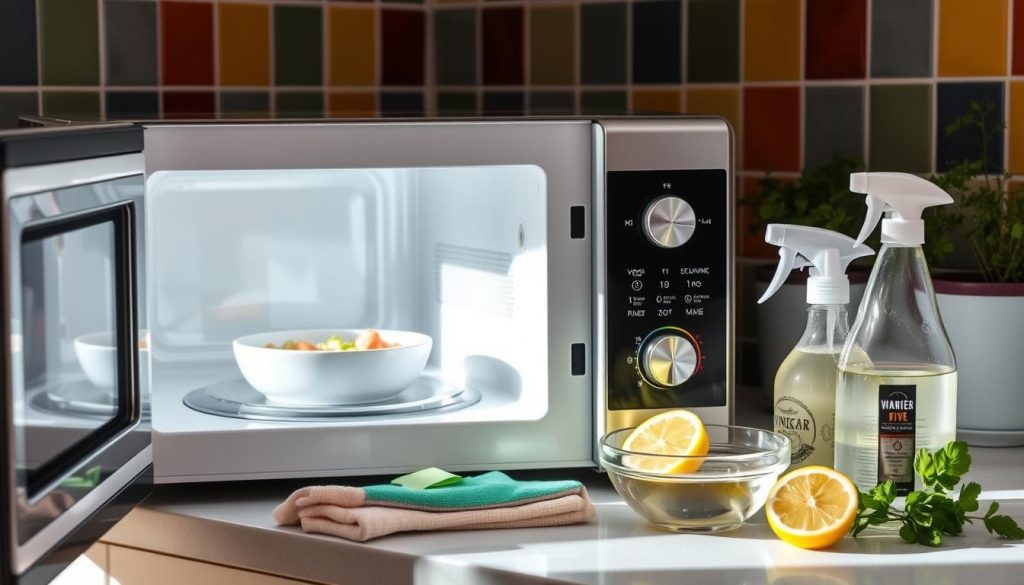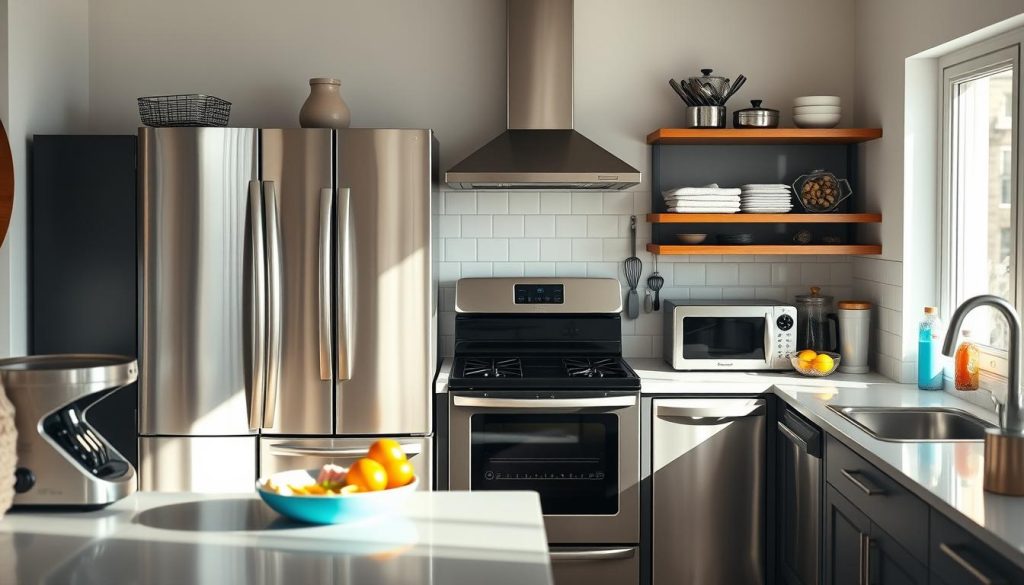Keeping your kitchen appliances in good shape is key. It helps them last longer, saves energy, and avoids expensive fixes. As a homeowner, setting up a regular maintenance plan is vital. This guide offers useful tips for caring for all your kitchen appliances, from big ones like refrigerators and ovens to small gadgets.
Key Takeaways
- Establish a regular maintenance schedule to extend the lifespan of your kitchen appliances
- Properly clean and maintain appliance components to improve energy efficiency
- Identify and address minor issues before they escalate into major, costly repairs
- Regularly check and replace worn parts to ensure optimal appliance performance
- Follow manufacturer’s instructions for safe and effective appliance care
Understanding the Importance of Regular Kitchen Appliance Maintenance
Keeping your kitchen appliances in good shape is key to their long life and efficiency. Regular care extends their life and saves you money and energy. By focusing on preventive maintenance, you protect your investment and make cooking easier.
Cost Benefits of Preventive Maintenance
Cleaning and maintaining your kitchen appliances can save you a lot of money. Preventive care fixes small problems before they become big, expensive issues. This way, you avoid costly repairs and replacements.
Impact on Appliance Lifespan
Proper maintenance is crucial for your appliances’ longevity. Regular cleaning and checks keep them running smoothly. With proper care, your appliances will last longer, giving you more value for your money.
Energy Efficiency Benefits
Well-maintained appliances use less energy, which means lower bills and a greener home. Dirty or blocked parts make appliances work harder and use more power. Keeping your appliances clean and tuned saves you money and helps the environment.
Investing time in regular maintenance pays off big time. By understanding the value of preventive care, you protect your appliances, save money, and help the planet.
Kitchen Appliance Maintenance Tips for Daily Care
Keeping your kitchen appliances in top shape is key for their long life and best performance. Simple daily habits can help your appliance cleaning last longer. Here are some easy tips to keep your kitchen appliances working well:
- Promptly wipe up spills: Cleaning spills right away stops stains and buildup. Use a damp cloth or paper towel to clean messes fast.
- Microwave upkeep: Clean the inside of your microwave after each use with a damp cloth or sponge. This removes food residue and prevents odors and fires.
- Maintain proper usage: Don’t overload your appliances or use them for things they’re not made for. Follow the manufacturer’s advice for best use and longevity.
- Perform quick maintenance tasks: Regularly check and clean parts like oven racks, dishwasher filters, and fridge drawers. These small steps can greatly improve your appliances’ efficiency.
By making appliance cleaning and microwave upkeep part of your daily routine, you’ll make your kitchen appliances last longer. You’ll also enjoy their reliable performance for many years.
“Consistent, preventive maintenance is the key to ensuring your kitchen appliances operate at their best for years to come.”
Refrigerator Care and Maintenance Essentials
Keeping your refrigerator in good shape is key for food safety and saving energy. It’s important to clean the condenser coils and check the door seals. These steps help your fridge work its best.
Cleaning Condenser Coils
The condenser coils at the back or bottom of your fridge collect dust and dirt. This can make your fridge work harder. Refrigerator maintenance means cleaning these coils with a brush or vacuum. Doing this can make your fridge more energy-efficient and last longer.
Door Seal Maintenance
The door seals are vital for keeping your fridge cool and preventing cold air from escaping. Check and clean the seals often to spot any damage. Appliance cleaning the seals with soap and water keeps them flexible and prevents them from drying out.
Temperature Control Settings
It’s important to keep the fridge at the right temperature for food safety and energy use. Check and adjust the fridge’s temperature settings. Aim for 35-40°F in the main area and 0°F in the freezer. Regular checks and adjustments help keep your fridge running well.
| Maintenance Task | Frequency | Benefits |
|---|---|---|
| Cleaning Condenser Coils | Every 6 months | Improved energy efficiency and extended appliance lifespan |
| Inspecting and Cleaning Door Seals | Every 3 months | Maintains internal temperature and prevents cold air loss |
| Adjusting Temperature Settings | Monthly | Ensures food safety and optimal energy usage |
By following these refrigerator maintenance and appliance cleaning tips, you can keep your fridge running smoothly. This saves energy, extends your fridge’s life, and saves money. Regular care also prevents expensive repairs and keeps your food safe.
Dishwasher Maintenance and Cleaning Guide
Keeping your dishwasher in good shape is key for clean dishes and efficient use. This guide offers tips and techniques to maintain your dishwasher. This way, you’ll get sparkling results every time.
Cleaning the Filters
The dishwasher’s filters are important for catching food particles. Cleaning them regularly helps your dishwasher work better. Use a soft-bristled brush and warm, soapy water to clean the filters.
Addressing Hard Water Buildup
Hard water can cause mineral deposits in your dishwasher. This can make it less efficient and leave spots on dishes. Run a cleaning cycle with a hard water remover or vinegar solution. Also, think about getting a water softener to lessen hard water’s effects.
Proper Loading Techniques
Load your dishwasher right to get the best cleaning. Place dishes and pans so water and detergent can reach them. Don’t overlap items and make sure spray arms can move freely.
Troubleshooting Common Issues
If your dishwasher isn’t working right, check for clogged drains, broken heating elements, or faulty door seals. Look at the manufacturer’s guide or get help from a pro if you can’t fix it.
Cleaning Products for Optimal Performance
Use top-notch dishwasher detergents, rinse aids, and cleaners made for dishwashers. These products help break down tough food, prevent mineral buildup, and leave dishes sparkling.
| Dishwasher Maintenance Task | Frequency |
|---|---|
| Clean the filters | Monthly |
| Run a dishwasher cleaning cycle | Every 3-6 months |
| Check and clean the spray arms | Annually |
| Inspect and replace the door seal (if needed) | Every 2-3 years |
By following these maintenance and cleaning tips, you can make your dishwasher last longer. You’ll also get better performance and cleaner dishes every time.

Essential Oven and Stovetop Maintenance
Keeping your oven and stovetop in good shape is key for great cooking, saving energy, and staying safe. This section will guide you through deep cleaning, burner care, and how to check the temperature. These steps will help keep your kitchen appliances working well.
Deep Cleaning Methods
Deep cleaning is the first step in maintaining your oven and stovetop. Start by taking out all parts you can, like racks and burners. Soak them in warm, soapy water to get rid of grime.
For the oven’s inside, mix baking soda with water to make a paste. Apply it to the walls and let it sit before wiping it off. On the stovetop, use a special cleaner and a scrub pad to remove tough spills and buildup.
Burner Care Tips
- Check gas burners for blockages and clean them with a toothpick or small wire brush.
- For electric coil burners, lift them up and clean underneath with a damp cloth to remove food or debris.
- Make sure all burners are aligned and seated right for even heating and fuel/electricity use.
Temperature Calibration
Having the right oven temperature is vital for baking and roasting. Use an oven thermometer to check the actual temperature against what it shows. If it’s off, adjust it. Your owner’s manual should have instructions on how to do this for your oven model.
By using these oven cleaning and stove maintenance tips, you can make your kitchen appliances last longer. You’ll also save energy and get better cooking results every time.
Microwave Care and Safety Protocols
Keeping your microwave oven in good shape is key for safety and performance. Regular microwave upkeep and appliance cleaning can make it last longer. This section will show you how to care for your microwave and stay safe.
Cleaning Techniques for Microwave Ovens
First, clean your microwave to keep it in top shape. Unplug it and wipe the inside with a damp cloth or paper towel. For tough spots, mix warm water and mild soap, then use a soft sponge to clean.
Don’t use harsh chemicals or rough cleaners. They can harm the microwave’s inside.
Safety Considerations for Microwave Use
- Make sure the microwave door seals well and the safety switches work right.
- Never use the microwave with the door open. It’s not safe.
- Be careful when taking out hot dishes. Use oven mitts or potholders to avoid burns.
- Don’t put metal things like aluminum foil or utensils in the microwave. They can cause sparks and damage.
Troubleshooting Common Microwave Issues
If your microwave isn’t working right, there are a few things you can check. If food isn’t heating evenly, check the turntable. It should spin smoothly.
Strange noises might mean a problem with the magnetron or fan motor. You might need a pro to fix it. Sometimes, you might need a new microwave if it’s old or broken.

| Microwave Maintenance Task | Frequency |
|---|---|
| Interior Cleaning | Weekly |
| Condenser Coil Cleaning | Every 6 Months |
| Turntable Inspection | Monthly |
| Door Seal Replacement | As Needed |
By following thesemicrowave upkeepandappliance cleaningtips, you can keep your microwave safe and working well. This helps your kitchen stay efficient.
Small Appliance Maintenance Strategies
Keeping your small kitchen appliances in good shape is key. This includes blenders, food processors, coffee makers, toasters, and toaster ovens. Regular care and cleaning can make these appliances last longer and work better.
Blender and Food Processor Care
Blenders and food processors are vital for making tasty smoothies and dips. Clean the blades, jars, and housing often. After each use, take them apart and wash with warm, soapy water.
Don’t soak the motor base in water. Instead, clean it with a damp cloth. For a deeper clean, check the manufacturer’s guide for the best methods and how often to do it.
Coffee Maker Maintenance
Descaling your coffee maker regularly is crucial. It stops mineral buildup and keeps your coffee tasting great. You should descale every 3-6 months, using a commercial solution or vinegar and water mix.
Also, clean the parts you can remove, like the carafe and filter basket, after each use. This keeps them clean and working well.
Toaster and Toaster Oven Upkeep
Crumbs and grease can build up in toasters and toaster ovens. This can be dangerous and lower their performance. Turn off the appliance and use a soft-bristled brush or damp cloth to clean out debris.
For a deeper clean, follow the manufacturer’s guide for disassembly and cleaning.
By following these maintenance tips, you can make your kitchen tools last longer. They’ll stay efficient and keep giving you great results for years.
Seasonal Maintenance Checklist for Kitchen Appliances
Keeping your kitchen appliances in top shape all year is key. A seasonal maintenance checklist helps them last longer and work better. This is especially true during busy times like holidays or vacations.
Begin by giving your fridge, oven, and big appliances a deep clean in spring and fall. Clean the inside, the condenser coils, and check the gaskets for damage. Also, adjust the temperature settings to save energy and keep food fresh.
Before summer, check your dishwasher’s performance. Clean the filters, look for blockages, and run a cleaning cycle. In the fall, focus on your oven and stovetop. Do a deep clean and adjust the temperature settings.


